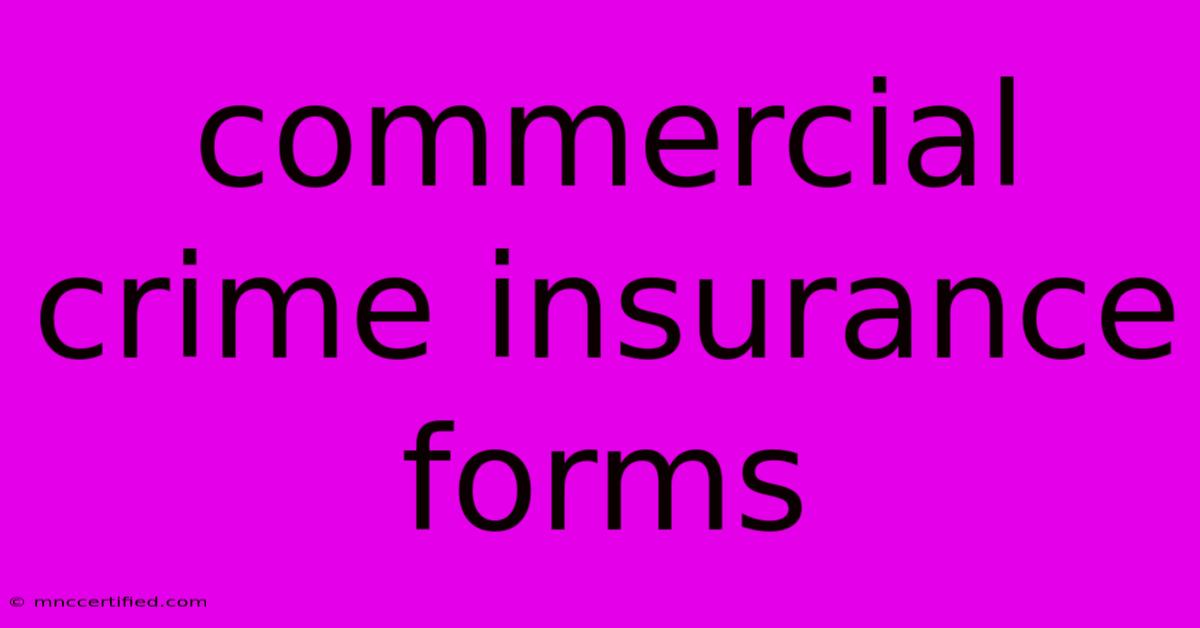Commercial Crime Insurance Forms

Table of Contents
Decoding Commercial Crime Insurance Forms: A Comprehensive Guide
Commercial crime insurance protects your business from various financial losses caused by dishonest employees, theft, or forgery. Understanding the forms and intricacies of this crucial coverage is vital for securing your company's financial well-being. This guide will dissect the key aspects of commercial crime insurance forms, helping you navigate the complexities and choose the right coverage for your specific needs.
Types of Commercial Crime Insurance Forms
Commercial crime insurance isn't a one-size-fits-all solution. Different forms cater to specific types of losses. The most common include:
1. Employee Dishonesty Coverage:
This is arguably the most important component for many businesses. It covers losses resulting from the dishonest acts of your employees, such as embezzlement, theft, or forgery. Key considerations when reviewing this section of your form include:
- Coverage Limits: How much will the insurer pay for losses caused by employee dishonesty? This should be carefully assessed based on your business's financial exposure.
- Employee Eligibility: Does the coverage extend to all employees, or are there exclusions? Pay close attention to any limitations based on position or employment status.
- Discovery Period: This specifies the time frame after the policy expires during which you can still file a claim. Longer discovery periods are beneficial.
2. Forgery or Alteration Coverage:
This protects your business against losses incurred from forged or altered checks, invoices, or other financial documents. Key points to examine:
- Specific Types of Documents Covered: The form should clearly outline which types of documents are included under this coverage.
- Limits of Liability: Understand the maximum amount the insurer will pay for losses related to forgery or alteration.
3. Customer and Vendor Fraud Coverage:
This covers losses due to fraudulent activities perpetrated by customers or vendors, such as fake invoices or check fraud. Important aspects to review:
- Specific Types of Fraud Covered: The policy should clearly detail the types of customer and vendor fraud included.
- Prevention Measures: Many insurers require businesses to implement reasonable fraud prevention measures to qualify for this coverage.
4. Money and Securities Coverage:
This protects against losses from theft of money or securities (stocks, bonds, etc.) from your business premises. Essential elements to consider:
- Location of Coverage: Verify whether the coverage applies only to your business premises or extends to other locations where you might keep money or securities.
- Methods of Loss: Ensure the policy covers losses due to various methods, including robbery, burglary, and mysterious disappearance.
Understanding the Fine Print: Exclusions and Limitations
Every commercial crime insurance form contains exclusions and limitations. These are crucial aspects to thoroughly understand. Common exclusions might include:
- Losses caused by intentional acts: If you knowingly participate in a fraudulent activity, you won’t be covered.
- Losses resulting from dishonest acts by partners or owners: Coverage often doesn't extend to the business owners themselves.
- Losses caused by employees related to the insured: This might exclude losses caused by family members or close associates of the insured.
- Losses caused by a lack of reasonable security measures: Your insurer might deny claims if you failed to take necessary precautions to safeguard your assets.
Pro Tip: Always consult with an insurance professional to review your specific policy and ensure it adequately protects your business.
Choosing the Right Coverage: A Tailored Approach
Selecting the appropriate commercial crime insurance depends heavily on your specific business needs and risk profile. Consider factors such as:
- Industry: Certain industries face a higher risk of specific types of crime.
- Business Size: Larger businesses often have greater exposure to losses.
- Financial Controls: Your existing internal controls and security measures can influence the level of coverage needed.
Don’t hesitate to ask your insurance provider to explain any aspect of the policy you don't understand. A clear understanding of your commercial crime insurance form is essential for effective risk management and financial protection.
Off-Page SEO Considerations:
To boost your article's ranking, consider the following off-page SEO strategies:
- Guest Blogging: Write guest posts on relevant websites in the insurance or business sectors, including links back to this article.
- Social Media Promotion: Share the article on relevant social media platforms.
- Backlink Building: Reach out to other websites in the insurance niche and encourage them to link to your article.
- Directory Submissions: List your article in relevant online directories.
By understanding the intricacies of your commercial crime insurance forms and implementing both on-page and off-page SEO strategies, you can effectively protect your business and ensure its long-term financial health.

Thank you for visiting our website wich cover about Commercial Crime Insurance Forms. We hope the information provided has been useful to you. Feel free to contact us if you have any questions or need further assistance. See you next time and dont miss to bookmark.
Featured Posts
-
Remembering Ken Reid Taoiseachs Statement
Nov 22, 2024
-
Michigan Company Recalls Contaminated Beef
Nov 22, 2024
-
Storm Bert Amber Warning Transport Scotland
Nov 22, 2024
-
Burghart And Rayner Pmqs Showdown
Nov 22, 2024
-
Ken Reid Veteran Journalist Remembered
Nov 22, 2024